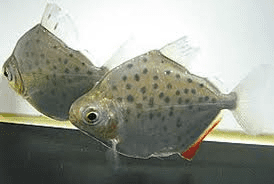
Common name: Spotted Silver Dollar
Scientific name: Metynnis Lippincottianus
Average Adult Fish Size: 5 inches / 12 cm
Place of Origin: Native to northern parts of the Brazilian Amazon as well as a handful of rivers in French Guiana.
Typical Tank setup: Inhabits densely planted river tributaries in the wild. The difficulty in replicating this in captivity is that the species is an avid plant-eater! Hardy plants should be chose but will still need to be replaced regularly. Artificial plants could be used as an alternative as some of the fabric and silk-type plants that are now available make convincing fakes. Metynnis can be nervous fish, so dim lighting and areas of refuge will boost their confidence. Inhabits areas of rapid water in the wild, so will enjoy a decent waterflow in the aquarium.
Recommended Minimum Aquarium Capacity: 55 gallon / 240 litre
Compatibility: Best kept in groups of at least five fish. Generally peaceful community fish and can be kept with other larger peaceful species. Much smaller fish may be eaten. Metynnis mainly occupy the middle and top areas of the aquarium, so it is a good idea to select tank mates that occupy both the bottom of the tank to add contrast. Larger peaceful catfish such as plecos and doradids would be a good choice.
Temperature: 73 – 81 Deg F / 23 – 27 Deg C
Water chemistry: pH 6.0 – 7.0
Feeding: Provide a large amount of vegetable matter in the diet, including; courgette, cucumber, peas, spring greens and other green vegetables. Commercial foods such as algae wafers, spirulina and vegetable flake are also recommended. Silver dollars will also accept the majority of aquarium foods and will relish such treats as bloodworm and brineshrimp.
Sexing: Anal fin is more elongated on the male and a red tinge may be present.
Breeding: No report of breeding in the hobby.
Additional Information: Metynnis lippincottianus is occasionally seen for sale, sometimes under the name of “Silver Dollar”. It is easily distinguishable from m. argenteus and m. hypsauchen (which are more commonly sold as Silver Dollars) by its spotted pattern, hence the common name. M. lippincottianus shares a common name with m. maculatus but the two can be distinguished as the spots on m. maculatus are more pronounced.


Related Posts
Croaking Gourami – Trichopsis vittatus
Benthochromis Tricoti
Large-eyed Mouthbrooder – Callochromis Macrops